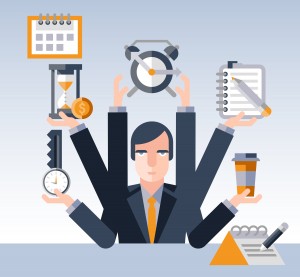
Faculty, School of STEM at American Public University
Are Multitaskers More Effective Learners and Workers?
In a 2014 survey of the most desired employee “soft” skills, 57% of employers reported seeking multitaskers. Presumably, multitaskers are more efficient at task completion, but is this actually true? Given multitasking’s increasing rank as a desired skill, it’s important to understand its implications and consequences for learning and working in our modern techno-world. Long before the current technological revolution, research suggested limits on how well two or more concurrent tasks could be completed.
Does Multitasking Increase Performance?
In today’s world, one shifts focus frequently to cope with information inundation. Constant shifts in focus place considerable demands on cognitive processes and resources, leading to a decrease in performance. Additional research confirms this performance reduction, which suggests that focusing on a single primary task results in better resource direction and adequate processing, encoding, and storing of tasks. Uninterrupted processing yields minimal errors with respect to information retrieval.
The addition of subsequent tasks, however, results in division of these resources and fragmented processing. The quality and quantity of stored information decreases because of this disrupted encoding. Consequently, information retrieval from this interrupted processing (multitasking) results in significantly more errors and decreased performance.
Applications for Learning
In the classroom, students frequently alternate their focus between academic and non-academic tasks. Examples of primary academic tasks may include listening to a lecture, synthesizing and organizing information, writing or typing notes, etc. If a non-academic task is added, attention shifting must occur between primary and secondary tasks. The result is impeded information that is coded into long-term memory.
The most popular tool for these secondary tasks during class is still the laptop computer, though smartphone and other mobile device usage continues to rise quickly. Research indicates that when technological devices are not used for academic purposes, students report decreased learning satisfaction and increased distraction. Over 60% of students surveyed regularly used their devices for games (73%), music (67%), entertainment (64%), and social networking (64%). Over half (53%) engaged with photo or video applications.
Consequences of Multitasking
Multitasking carries consequences for learning. Among post-secondary students, multitasking continues to increase, with one study suggesting that it comprises approximately 42% of a student’s class time. The result is consistent impaired comprehension and performance.
In one experimental study, students were assigned to one of three groups: (1) an experimental multitasking group who used Facebook, MSN Messenger, email or cell phone texting, (2) a control group (taking notes with paper and pencil or with a laptop) or (3) a group with the freedom of choice to either multitask or to not use as many applications as desired. Content comprehension was assessed via a quiz after three class sessions, and control group scores were higher than the other groups.
Another study included 262 students who were self-proclaimed good multitaskers and who believed this skill positively contributed to their performance. Results indicated that performance by non-multitaskers was more effective than multitaskers.
The Verdict?
Technological ubiquity has fostered the prevalence of multitasking, making it a very timely issue in education and the workforce. But is multitasking really an advantageous “skill,” or is it simply a reflection of cultural literacy? Has the speed of task completion become worth the consequences of decreased cognitive capacity and problem-solving skill? Instead of promoting multitasking as a desired goal, perhaps we should look for ways to limit the “need” for multitasking, both in the classroom and the workplace, to increase learning and performance.
About the Authors
Jim Brinson is an Assistant Professor in the School of Science, Technology, Engineering and Math at American Public University. His teaching and research interests include biological chemistry and science education, with a current focus on science laboratory education in non-traditional learning environments.
Kasie Brinson is an Adjunct Instructor in the School of Science, Technology, Engineering and Math at American Public University. Her areas of interest include plant and general biology and the online teaching and learning of science.

Comments are closed.